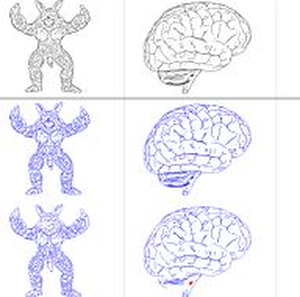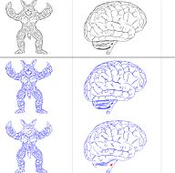Information
- Publication Type: Master Thesis
- Workgroup(s)/Project(s):
- Date: May 2019
- Date (Start): 1. July 2017
- Date (End): 27. May 2019
- TU Wien Library:
- Diploma Examination: 27. May 2019
- Open Access: yes
- First Supervisor: Ivan Viola
- Pages: 84
- Keywords: visualization
Abstract
Advanced rendering algorithms such as suggestive contours are able to depict objects in the style of line drawings with various levels of detail. How to select an appropriate level of detail is based on visual aesthetics rather than on substantial characteristics like the accuracy of 3D shape perception. The aim of this thesis is to develop a novel approach for effectively generating line drawings in the style of suggestive contours that are optimized for human 3D shape perception while retaining the amount of ink to a minimum. The proposed post-processing meta-heuristic for optimizing line drawings uses empirical thresholds based on probing human shape perception. The heuristic can also be used to optimize line drawings in terms of other visual characteristics, e.g., cognitive load, and for other line drawings styles such as ridges and valleys. The optimization routine is based on a conducted perceptual user study using the gauge figure task to collect more than 17, 000 high-quality user estimates of surface normals from suggestive contours renderings. By analyzing these data points, more in-depth understanding of how humans perceive 3D shape from line drawings is gained. Particularly the accuracy of 3D shape perception and shape ambiguity in regards to changing the level of detail and type of object presented is investigated. In addition, the collected data points are used to calculate two pixel-based perceptual characteristics: the optimal size of a local neighborhood area to estimate 3D shape from and the optimal local ink percentage in this area. In the analysis, a neighborhood size of 36 pixels with an optimal ink percentage of 17.3% could be identified. These thresholds are used to optimize suggestive contours renderings in a post-processing stage using a greedy nearest neighbor optimization scheme. The proposed meta-heuristic procedure yields visually convincing results where each pixel value is close to the identified thresholds. In terms of practical application, the optimization scheme can be used in areas where high 3D shape understanding is essential such as furniture manuals or architectural renderings. Both the empirical results regarding shape understanding as well as the practical applications of the thesis’s results form the basis to optimize other line drawing methods and to understand better how humans perceive shape from lines.Additional Files and Images
Weblinks
BibTeX
@mastersthesis{plank-2017-sldg,
title = "Effective Line Drawing Generation",
author = "Pascal Plank",
year = "2019",
abstract = "Advanced rendering algorithms such as suggestive contours
are able to depict objects in the style of line drawings
with various levels of detail. How to select an appropriate
level of detail is based on visual aesthetics rather than on
substantial characteristics like the accuracy of 3D shape
perception. The aim of this thesis is to develop a novel
approach for effectively generating line drawings in the
style of suggestive contours that are optimized for human 3D
shape perception while retaining the amount of ink to a
minimum. The proposed post-processing meta-heuristic for
optimizing line drawings uses empirical thresholds based on
probing human shape perception. The heuristic can also be
used to optimize line drawings in terms of other visual
characteristics, e.g., cognitive load, and for other line
drawings styles such as ridges and valleys. The optimization
routine is based on a conducted perceptual user study using
the gauge figure task to collect more than 17, 000
high-quality user estimates of surface normals from
suggestive contours renderings. By analyzing these data
points, more in-depth understanding of how humans perceive
3D shape from line drawings is gained. Particularly the
accuracy of 3D shape perception and shape ambiguity in
regards to changing the level of detail and type of object
presented is investigated. In addition, the collected data
points are used to calculate two pixel-based perceptual
characteristics: the optimal size of a local neighborhood
area to estimate 3D shape from and the optimal local ink
percentage in this area. In the analysis, a neighborhood
size of 36 pixels with an optimal ink percentage of 17.3%
could be identified. These thresholds are used to optimize
suggestive contours renderings in a post-processing stage
using a greedy nearest neighbor optimization scheme. The
proposed meta-heuristic procedure yields visually convincing
results where each pixel value is close to the identified
thresholds. In terms of practical application, the
optimization scheme can be used in areas where high 3D shape
understanding is essential such as furniture manuals or
architectural renderings. Both the empirical results
regarding shape understanding as well as the practical
applications of the thesis’s results form the basis to
optimize other line drawing methods and to understand better
how humans perceive shape from lines.",
month = may,
pages = "84",
address = "Favoritenstrasse 9-11/E193-02, A-1040 Vienna, Austria",
school = "Research Unit of Computer Graphics, Institute of Visual
Computing and Human-Centered Technology, Faculty of
Informatics, TU Wien",
keywords = "visualization",
URL = "https://www.cg.tuwien.ac.at/research/publications/2019/plank-2017-sldg/",
}

 image
image Master Thesis
Master Thesis

